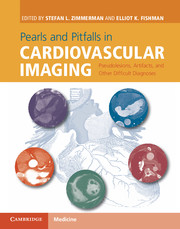 Pearls and Pitfalls in Cardiovascular Imaging
Pearls and Pitfalls in Cardiovascular Imaging from Section 1 - Cardiac pseudotumors and other challenging diagnoses
Published online by Cambridge University Press: 05 June 2015
Imaging description
Hypertrophic cardiomyopathy (HCM) is a diagnosis made when myocardial wall thickness exceeds 15 mm in the absence of any explanatory cardiac disease. Importantly, there are several uncommon reasons for cardiac hypertrophy that can mimic the appearance of HCM and should be considered whenever making the diagnosis. One such entity is cardiac amyloidosis. Cardiac amyloidosis is notable for concentric left and right ventricular hypertrophy in combination with diastolic dysfunction, features that overlap with HCM. Unlike the majority of HCM cases, however, hypertrophy in amyloid is diffuse and symmetric (Figure 11.1). Amyloid also has a characteristic pattern of late gadolinium enhancement (LGE), which is diffuse, concentric, and subendocardial, unlike the patch distribution of LGE seen in HCM (Figure 11.1). In addition, amyloid causes alterations in the kinetics and distribution of gadolinium contrast, which results in poor differentiation between the myocardium and blood pool on LGE images due to absorption of gadolinium by amyloid proteins in both the blood and heart. A second major diagnostic consideration when evaluating for HCM is a metabolic disorder such as Anderson-Fabry disease or, less commonly, Danon disease (Figure 11.2). These patients are typically young with left ventricular hypertrophy, similar to HCM, and midwall LGE, often confined to the basal inferolateral wall.
Importance
Mimics of HCM are important to recognize given that their treatment and prognosis significantly differ from that of HCM. Referring clinicians should be made aware of the possibility of alternative diagnoses so that additional testing is ordered.
Typical clinical scenario
Mimics of HCM are less common than HCM itself. Amyloidosis is uncommon, affecting 10 per million person years in the United States. The heart is involved in 90% of patients with systemic AL, or primary, amyloidosis, the most common of several types of amyloidosis. More than half of patients will die from arrhythmia or heart failure. Anderson-Fabry disease is the most common of the metabolic syndromes that result in myocardial hypertrophy. It is an x-linked disorder that is found in approximately 1:40,000 males; females are rarely affected.
To save this book to your Kindle, first ensure [email protected] is added to your Approved Personal Document E-mail List under your Personal Document Settings on the Manage Your Content and Devices page of your Amazon account. Then enter the ‘name’ part of your Kindle email address below. Find out more about saving to your Kindle.
Note you can select to save to either the @free.kindle.com or @kindle.com variations. ‘@free.kindle.com’ emails are free but can only be saved to your device when it is connected to wi-fi. ‘@kindle.com’ emails can be delivered even when you are not connected to wi-fi, but note that service fees apply.
Find out more about the Kindle Personal Document Service.
To save content items to your account, please confirm that you agree to abide by our usage policies. If this is the first time you use this feature, you will be asked to authorise Cambridge Core to connect with your account. Find out more about saving content to Dropbox.
To save content items to your account, please confirm that you agree to abide by our usage policies. If this is the first time you use this feature, you will be asked to authorise Cambridge Core to connect with your account. Find out more about saving content to Google Drive.